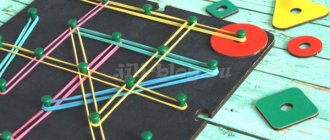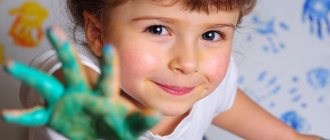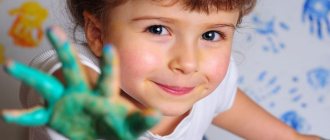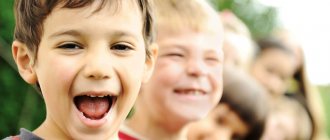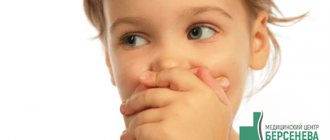The accumulated experience is not only about adults who are wise in life. A four-year-old child also has his own - albeit small, but noticeable compared to previous periods of development - life experience. At 4 years old, a child is still a baby, especially in the eyes of his parents: he talks funny, is surprised by new things and asks a lot of questions. But maturation is noticeable even in the appearance of a four-year-old. Childhood swelling smooths out, and the child begins to resemble a small adult.
If developmental norms for three-year-old children are more variable, then for four-year-olds these norms are already outlined quite clearly. Knowing what a 4-year-old child should be able to do, parents will be able to track and correct possible deviations.
Content:
- Basic knowledge and skills at 4 years old
- Norms of physical development Differences between boys and girls
- Weight and height
- Physical skills
- What if the child does not speak or speaks poorly?
How to calculate the volume of active and passive vocabulary?
Finding out the approximate number of words in a passive dictionary is easy. It is enough to ask the child to show a certain object, action, object (for example, a cat). If the child did everything correctly, then the word is counted in the passive dictionary.
Now let’s calculate the size of the active dictionary. What should you consider?
- Words that the child pronounces clearly: “give”, “mom”, “dad”.
- Onomatopoeia for animals and objects: car “beep-beep”, dog “woof-woof”.
- Reproduction of incomplete words: “baka” - dog.
- Words that are pronounced incorrectly, but the number of syllables and stress are correct: “patina” - machine.
- Words that are pronounced the same, but have different meanings (this is the norm up to 2.5 years): “ma” - mom, car, meow (each word is counted separately).
“To make it easier to count active vocabulary and clearly see the progress and dynamics of a child’s development, you need to keep a diary of speech development. Every month you can enter the words that your child has mastered. From 2.5-3 years old, keeping track of every word will be quite difficult due to the growing talkativeness. Then you can write down the baby’s funny sayings in your diary, which you will be happy to re-read in the future,” the speech therapist advises.
Basic knowledge and skills at 4 years old
What a child should be able to do at four years old - basic knowledge and skills:
- good control of your body: confidently move and navigate in space;
- be able to count to five and know what numbers up to five look like;
- it is enough to speak well: speech should become clearer compared to the age of three;
- possess self-service skills;
- understand some social norms: for example, distinguish good actions from bad ones.
Norms of physical development
Between three and four years of age, a child does not grow as quickly as at an earlier age. But the acquired physical and motor skills are sharpened, and new ones appear. At the age of four, differences in the physical abilities of boys and girls become noticeable.
Differences between boys and girls
Although the weight and height of four-year-old children of different sexes are still the same on average, the difference in physical development is already clearly visible:
- Boys at 4 years old run faster, outperform their peers in outdoor games, and learn to ride a bicycle well earlier.
- Girls at the age of four are ahead of their peers in intellectual development: they construct complex sentences, solve logical problems correctly, and easily memorize poetry.
Researchers who studied the thinking characteristics of preschool children found that this difference in development between boys and girls is associated with the structure of the brain. Four-year-old girls have a well-developed left hemisphere of the brain, which is responsible for developed intelligence and fluent speech.
With age, intellectual differences between children of different sexes are erased, and physical differences become even more noticeable.
Weight and height
The average height of children at four years old is 102-103 centimeters. Average weight - 16-18 kilograms. There may be deviations up or down from the average height and weight, depending on hereditary factors and the lifestyle of a particular child.
If your baby's height at 4 years is less than 94 centimeters, or he weighs less than 12 or more than 25 kilograms, it may be worth changing his daily routine and diet after consulting a pediatrician.
The norm of weight and height specifically for your son or daughter can be calculated as follows: in the interval between three and four years, the child should grow by 6-7 centimeters, and the weight should increase by 1-3 kilograms.
Physical skills
Physical skills that most 4-year-olds master:
- confidently handle a tricycle or scooter;
- eat completely independently, using cutlery deftly and as intended;
- know how to handle small parts of objects: correctly form multi-level pyramids, assemble construction sets and puzzles according to instructions or with the help of an adult.
Early childhood and speech development
Early age (from birth to 3 years) is a special period in a child’s life. In terms of the intensity of development and the complexity of the tasks solved at this stage, the first years of life have no equal. This is also the most favorable period for mastering the basics of your native speech. What gets missed now may require double effort later!
Would it surprise you if we told you that a child's speech abilities begin to develop even before he is born? And this is exactly so. Let's find out what actually affects the development of speech in a baby.
What factors influence speech development
- Biological: heredity; correct structure and functioning of the central nervous system, speech centers in the brain, hearing and speech organs; healthy pregnancy and successful birth; healthy physical and mental development after birth.
- Social: a full-fledged speech environment from the first days of a child’s life, a favorable developmental environment.
Motor skills
The coordination of a four-year-old child is developing better and better, acquired motor skills are consolidated and new ones appear:
- knows how to jump high and far, knows how to somersault;
- tries to hit the target with the ball, catches and holds the ball with both hands;
- standing on one leg, maintains balance for at least 10 seconds, makes several jumps on one leg;
- becomes quite flexible, easily tilting the body from a standing or sitting position, for example, in order to put on shoes;
- can walk on tiptoes;
- Dresses and undresses without adult help, or with little help if you need to cope with a difficult fastener or laces.
Fine motor skills
The development of a baby’s speech and the correct development of thinking and memory depend on well-developed fine motor skills. It’s good if by the age of four the child has the following fine motor skills:
- colors pictures without going beyond the outline;
- tries to keep the pencil straight when drawing dots, does not lift his hand from the sheet of paper;
- traces samples and stencils with a pencil;
- launches the spinning top;
- folds his fingers, showing shapes, for example, “flashlight”;
- laces his own shoes or at least tries to manage the laces;
- strings buttons or beads with large holes onto a thread;
- Cuts out paper shapes with scissors fairly smoothly.
If your child does not yet master each of these skills, it is easy to help him: together learn to tie shoelaces, play with beads, show how to make finger figures.
Is learning languages good for speech?
Early learning of languages helps the development of a child’s speech if this process brings joy to parents and the baby. Therefore, you need to switch to the foreign language that you like best and know best.
Bilingual children begin to speak earlier from birth if both parents actively communicate with them.
“I often compare learning a second language to learning to swim,” Olga explains. If a child begins to master this activity at 3–4 months, then by the age of three he will already be able to swim perfectly independently. Then you can start teaching him how to ski, say. And if you start swimming at the age of three, then, of course, this process will take much longer, and parallel training in different sports can cause certain difficulties. It’s the same with languages.”
Sensory development and dental care
vision almost as as that of adults. Four-year-olds are rarely ready to read, but you can already introduce letters to your child. The main thing is to choose books, cards and other aids where the letters are printed in large font - this way the child’s vision will not be too strained.
hearing is already fully formed. The sense of smell is improved : the child feels and identifies complex odors. The skin remains sensitive to cold; the baby feels warmth in the same way as adults. Children aged four years feel the taste of food almost like adults, but with a slight difference: in a multi-component dish, the child mainly distinguishes the main component, poorly recognizing the nuances of taste of the remaining components.
Four-year-old children already have 16-20 baby teeth . Due to the fact that baby teeth are much more vulnerable than permanent teeth, you need to carefully monitor your child’s oral hygiene: teach your child to brush his teeth regularly and treat problem teeth in a timely manner. Keeping baby teeth healthy is very important: baby teeth removed early can cause improper jaw formation and lead to other problems. Thus, children who have lost their baby teeth early may have distorted facial features.
Speech of a child at 4 years old
The passive vocabulary of a 4-year-old child is 3,000 words: this includes those words that the baby actively uses in speech, and those whose meaning he knows, but rarely uses in speech. Passive vocabulary includes, for example, outdated words that are often found in fairy tales: plow, upper room, stupa and the like.
A four-year-old’s active vocabulary includes as many words as he needs to communicate with others—usually about 1,000 words.
What if the child does not speak or speaks poorly?
A child at the age of four can coherently tell how the day went, uses sentences of eight words or longer in speech, and clearly describes the objects he saw.
Speech development in four-year-old children may differ - girls usually speak quickly, while boys find it more difficult to find the right words. But if the child does not speak at all or severely distorts words, you should consult a pediatrician.
The absence of coherent speech at 4 years old may indicate delayed mental development, hearing problems, and severe stress. A pediatric neurologist, otolaryngologist and speech therapist will help parents understand the reason for the child’s silence.
Second language learning
Courses for studying English or another foreign language suggest starting to learn a second language at the age of four. At this age, children easily remember foreign names of objects and phenomena and are not shy about making mistakes.
But it is advisable that the child already has a fairly good command of Russian speech before starting to learn a second language - otherwise serious problems with the pronunciation of foreign words are inevitable, which will be difficult to correct later.
Developing vocabulary in children
From an early age, parents need to make efforts to ensure that the child’s vocabulary is constantly replenished with new names and concepts. What can be done for this?
- Read books. With the help of stories and fairy tales, we expand the child’s horizons, teach him to perceive new information, fantasize and dream. For example, a child will be able to see a live toucan or giraffe only in a zoo, but with the help of a book he will get acquainted with new animals, birds, and learn a lot of interesting things about them. For small children, buy books with bright, colorful illustrations. You can purchase publications with tactile pictures that your baby can touch with his fingers. Talk about everything the child sees in the picture: “Look what a beautiful farm! Where is the cockerel? And the chicken? Show me the pig, please."
- We talk more. From birth, pronounce your actions: “Now I’ll change you, and we’ll go for a walk,” “Mom will cook delicious porridge, and we’ll have breakfast.” While walking, tell your baby about trees, flowers, buildings. At home, name all the objects you pick up: toys, clothes, food, etc. Constantly talk to your child, use synonyms, and monitor the emotional coloring of your speech. Show the entire emotional palette of words so that the baby understands how mom feels when she explains or says something.
Socialization: communication, emotions
At 4 years old, the child knows and accepts the norms of behavior in society. In communicating with peers, a four-year-old learns to share, play his role in the game, and recognize good and bad deeds. The child increasingly strives to communicate with peers, gradually separating from his parents. True, there are exceptions: when the baby does not want to play with other children and is more interested in spending time alone. This behavior is a variant of the norm and indicates the child’s character traits.
When communicating with adults, a well-socialized 4-year-old child follows the rules of etiquette: addresses himself as “you” and by his first name and patronymic, and follows the rules of behavior in kindergarten or other institutions. By the age of four, a child should know that he can only trust familiar adults, and that he should not talk to strangers or go somewhere.
The range of emotions of four-year-old children is quite wide: they are able to recognize the emotions of other people, restrain their own emotions, and actively use facial expressions and gestures to express feelings.
A four-year-old needs his own space - this could be a separate room or a play corner - where he feels like he is the master. A child may perceive an invasion of personal space without permission, even from close people, as painful.
What to pay attention to
The development schedule for speech skills was given above. Children develop differently, and even the most talented talkers can only master all the necessary skills for their age group once they reach its upper limit. Therefore, the norms of timely development do not always serve as reliable guidelines for understanding whether a particular child is mastering speech correctly. We’ll take a different approach and tell you what should be the reason to contact a specialist:
- By the end of the 1st month, the baby does not cry before feeding;
- By the end of the 4th month he does not smile when spoken to and does not gurgle;
- By the end of the 5th month does not listen to music;
- By the 7th month, does not recognize the voices of loved ones, does not respond to intonations;
- By the end of the 9th month, there is no babbling and the child cannot repeat sound combinations and syllables after adults, imitating the intonation of the speaker;
- By the end of the 10th month, the baby does not wave his head as a sign of denial or his hand as a sign of goodbye;
- By the age of 1 year, the child cannot utter a word and does not fulfill the simplest requests (“give”, “show”, “bring”);
- By 1 year 4 months, cannot call mom “mom” or dad “dad”;
- By 1 year 9 months cannot pronounce 5–6 meaningful words;
- By the age of 2, does not show body parts that are named to him; does not comply with two-action requests (“go into the room and take a book”), does not recognize loved ones in photographs;
- At 3 years old, cannot retell short poems and fairy tales, cannot say his first and last name; speaks in such a way that others do not understand him; speaks very quickly, swallowing endings, or very slowly, drawing out words.
Psychological condition
Four-year-old children do not feel fear well - the task of parents is to tell their son or daughter about possible dangers: about potentially dangerous household appliances, about stray animals, about walking alone.
Normally, a psychologically developed child at the age of four should:
- take into account the assessment of your behavior by significant adults: parents, educators;
- be as independent as possible;
- be able to serve yourself in accordance with your age.
Cognitive development
At 4 years old, the baby strives to do a lot on his own, thanks to which his cognitive abilities develop intensively. The abilities of children attending a kindergarten or other preschool institution usually develop a little faster than those of children at home - communication with peers and regular classes with teachers have a positive effect on the formation of basic cognitive abilities: memory, attention, thinking.
Everyday skills
Four-year-old children can partially take care of themselves: dress and undress, carefully use the toilet, wash and brush their teeth. They are well oriented in their home, they know where specific things should be.
At 4 years old, the child himself strives to master new skills, and parents can teach him new skills in everyday life:
- to make one's bed;
- take dirty clothes to the laundry;
- keep order in a small area of the house, for example, in the bathroom.
Daily routine and child care
An approximate daily routine for a four-year-old child:
| 07.00 | Getting up, hygiene |
| 08.00 | Breakfast |
| 09.00 | Quiet games, educational activities |
| 10.00 | Walk |
| 12.00 | Dinner |
| 13.00 | Daytime nap |
| 15.00 | Afternoon snack |
| 16.00 | Active games or a walk |
| 18.00 | Dinner |
| 19.00 | Communication with family, developmental activities |
| 20.30 | Hygiene |
| 21.00 | Going to bed |
⠀ If a child does not attend kindergarten, at 4 years old he can refuse naps.
Four-year-olds need certain care from adults:
- remind your child of the importance of personal hygiene;
- walk longer in good weather;
- include hardening procedures in your daily routine: air and sun baths, rubdowns.
Vocabulary standards for different ages
Each child develops individually, but there are average indicators that parents can use as a guide:
- one-year-old child – up to 10 words;
- 1.5 years – from 20 to 40 words;
- 2 years – from 50 to 200 words;
- 3 years – up to 1000 words;
- 4 years – 1500-1900;
- 5 years – about 1100-1200;
- 6 years – 3200-3500 words.
When a baby begins to actively talk, his vocabulary is sharply replenished with new words. It increases every year, and by the age of 6-7 years the vocabulary can be more than 3,000 words.
When should you worry about your child's development?
Features of a child that at the age of four may indicate developmental delay:
- cannot concentrate on one activity even for a few minutes;
- does not control emotions, outbursts of aggression occur;
- does not play with toys and is not interested in them;
- does not use complex sentences in speech, generally has difficulty expressing thoughts orally;
- too mobile or, conversely, very slow.
If you notice such symptoms in a child, consult your local pediatrician.
How to help a child's development?
Activities that will help a 4-year-old child develop correctly:
- Simple physical and chemical experiments. For example, with water freezing in the cold, with mixing settled water with ink.
- Learning new mathematical concepts: “equal”, “wide-narrow”, “low-high”.
- Reading children's books, retelling their fragments. Retellings can begin with one paragraph; over time, the child will be able to retell a whole chapter.
- Applications and modeling.
- Age appropriate sports: skiing, swimming, running.
Games
Games for developing memory, attention and thinking of four-year-old children:
- Any role-playing games that allow children to use their imagination and imagine themselves in a new role. Such games can be improvised or organized: children can play classic “daughter-mother” games themselves or, under the guidance of an adult, play according to a pre-thought-out plot, for example, “One Day at School” or “At a Doctor’s Appointment.”
- Games to develop emotional intelligence. Ask your child to emotionally depict different moods: show a very tired person, a gloomy cloud, a smiling sun.
- The game “Come up with another name” perfectly develops children's imagination. Invite your child to come up with other names for common objects: a spoon is a “porridge scooper,” boots are “armor against dirt,” rags for wiping dust are “a weapon for cleaning.”
- Age-appropriate didactic games: sorters, puzzles, educational cards.
- Drawing blindly. The child draws without opening his eyes, and then comes up with what the resulting confusion could mean.
Despite noticeable maturation, the main activity for a four-year-old child remains playing. Try to include playful moments in different life situations - even the process of dressing can be framed as a fun game. Without feeling pressure and demands, your child will develop on time and at a pace that is comfortable for him!
Vocabulary games
- “Name the animal (plant, name, etc.).” Take the ball and place the children in front of you in a semicircle. Throw the ball to the children one by one: the child who caught the ball must name a word from a given thematic group and throw the ball back. The kid who couldn’t remember the word is eliminated from the game. The winner is the child who was able to stay in the game.
- "Edible - inedible." The presenter says any word and throws the ball to the child. If the word denotes an edible object, the child catches the ball; if it is inedible, he throws it away. The exercise helps to understand how correctly the child has mastered the meaning of words. For example, if a child claims that a plate belongs to the group of edible objects, there is reason to think about it.
- "Big small". The rules are the same as in the previous game. The presenter pronounces one word from a pair (“chair” or “high chair”, “table” or “little table”, “spoon” or “spoon”). If the child believes that the leader named a small object, he catches the ball, if it is large, he throws it away.
- "Package". Each player receives a “package” with some item. The child must describe his subject in detail so that others understand what he is talking about.
- "Analogies". Write the “equation” on the card: “A pigeon is a bird, a cat is a ?” The child must understand which thematic group the second word belongs to. This exercise helps you learn words with specific and general meanings.

